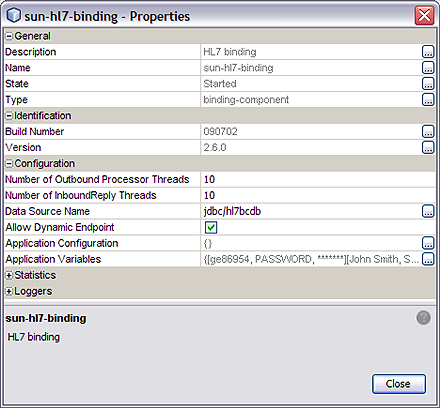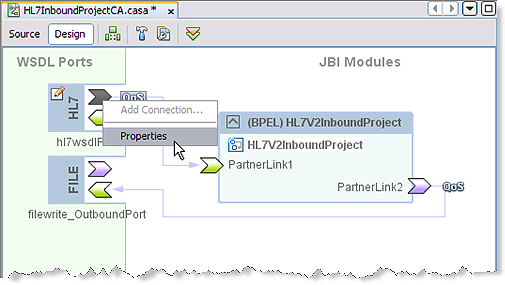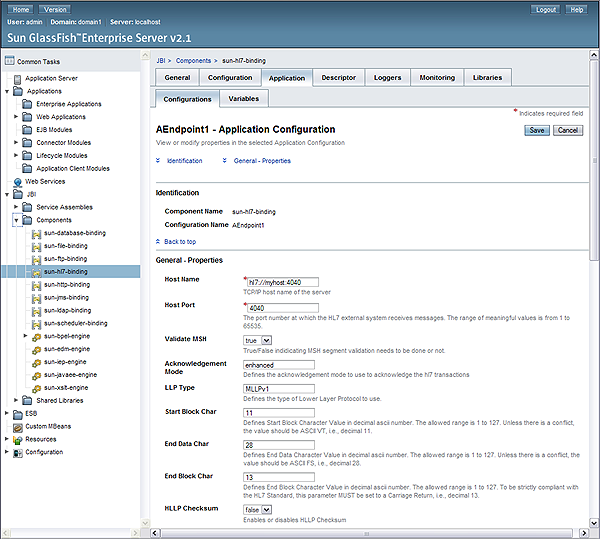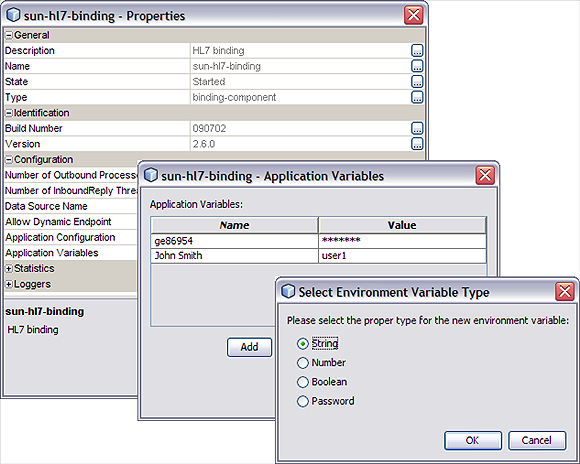| Skip Navigation Links | |
| Exit Print View | |

|
Oracle Java CAPS HL7 Binding Component User's Guide Java CAPS Documentation |
| Skip Navigation Links | |
| Exit Print View | |

|
Oracle Java CAPS HL7 Binding Component User's Guide Java CAPS Documentation |
Oracle HL7 Binding Component User's Guide
About the HL7 Binding Component
The Health Level 7 Messaging Standard
HL7 Binding Component as a Consumer
HL7 Binding Component as a Provider
HL7 Binding Component Features
Using the HL7 Binding Component Wizard
Accessing the HL7 Binding Component Wizard
To Access the Wizard by Creating a New File
To Access the Wizard by Creating a New Binding
To Access the Wizard by Creating a New WSDL Document
Configuring the HL7 Binding Component in the Wizard
To Configure the HL7 Binding Component in the Wizard
MLLP Version 2 Properties (Outbound Only)
HL7 Binding WSDL Extensibility Elements
Adding HL7 Extensibility Attributes From the WSDL Editor
To add Service Level HL7 Extensibility Attributes
Service Level HL7 Extensibility Elements
HL7 protocolproperties Element
HL7 communicationcontrols Element
Binding Level HL7 Extensibility Elements
Dynamically Configuring HL7 Endpoints
Dynamic Addressing Using Normalized Message Properties
Enabling Dynamic Endpoint Configuration
Using Normalized Message Properties in a BPEL Process
Using Predefined Normalized Message Properties in a BPEL Process
To Use Predefined Normalized Message Properties in a BPEL Process
General Normalized Message Properties
HL7 Binding Component Normalized Message Properties for Outbound Endpoints
HL7 Binding Component Normalized Message Properties for Inbound Endpoints
HL7 Binding Component Runtime Properties
Configuring the HL7 Binding Component Runtime Properties
To Edit HL7 Binding Component Runtime Properties
Defining an HL7 Binding Component Application Configuration
To Define the HL7 Application Configuration
Defining the Application Configuration Using Other Tools
Using Application Variables to Define Name/Value Pairs
Using Application Variables for Password Protection
Using HL7 Quality of Service (QoS) Features
Quality of Service (QoS) Properties
The runtime properties allow you to make changes to a project after the project's design time is completed, without touching the business logic. The runtime properties can be accessed from the Properties window or from the binding component's properties editor.
The runtime configuration for the HL7 Binding Component affects all HL7 Binding Components that are deployed on the domain you are configuring.
The Properties Editor appears.

Properties are described under HL7 Binding Component Runtime Properties.
The HL7 Binding Component's Application Configuration property allows you to change the configuration information for an endpoint without changing a projects business logic. The HL7 WSDL endpoint properties can be configured from the HL7 Binding Component Runtime Properties Editor.
The CASA Editor opens.

The HL7 WSDL Port Properties Editor appears.


The sun-hl7-binding Properties Editor appears.
The sun-hl7-binding Application Configuration Editor appears.

For more information about Application Configuration properties, see Application Configuration under Runtime Properties.
When the composite application is deployed, the HL7 Binding Component will use the new application configuration that has been defined for the respective endpoint.
In addition to the NetBeans IDE, you can also use these other tools to edit the HL7 Binding Component Application Configuration.
GlassFish Admin Console: To access the Admin Console, from the NetBeans Services window, right-click GlassFish V2 under Servers and then select View Admin Console. You can also access the Admin Console at http://localhost:4848/login.jsf, if this setting was retained during installation.
To open the Application Configuration window from the Admin Console, select the sun-hl7-binding, under Common Tasks -> JBI -> Components. Select the Application tab and the Configuration sub-tab.

asadmin Command Line Interface: For information on using the Command Line Interface (CLI) to create, edit, or delete and application, see create-jbi-application-configuration, update-jbi-application-configuration, or delete-jbi-application-configuration.
The binding component Application Variables property allows you to define a list of name:value pairs for a given stated type. The application variable name can be used as a token for a WSDL extensibility element attribute in a corresponding binding. For example, if you were defining an application variable for the hostname as FOO, then the WSDL attribute would be ${FOO}. In the Application Variables property you would enter a String value of FOO for the name and the desired attribute as the value. When you deploy an application that uses application variables, any variable that is referenced in the application's WSDL is loaded automatically.

The Application Variables configuration property offers four variable types:
String: Specifies a string value, such as a path or directory.
Number: Specifies a number value.
Boolean: Specifies a Boolean value. The VALUE field provides a checkbox (checked = true).
Password: Specifies a password value. The password is masked and displays only asterisks.
Variables also allow greater flexibility for your WSDL files. For example, you can use the same WSDL for different runtime environments by using application variables to specify system specific information. These values can then be modified from the binding component runtime properties as needed.
When you deploy an application that uses Application Variables, all of the Application Variables that are referenced in the application's WSDL files are loaded automatically. If you attempt to start an application and an Application Variables value is not defined (no value is specified for the Application Variable) an exception is thrown.
To change a property when the application is running, change your Application Variable property value, then right-click your application in the Services window under Servers -> GlassFish -> JBI -> Service Assemblies, and click Stop in the popup menu. When you restart your project, your new settings will take effect.
To protect passwords that would otherwise appear as clear text in your WSDL file, you can enter a password Application Variable as a token. In the following example, a password Application Variable is created that uses the name SECRET and the password PROTECT.
The sun-hl7-binding Properties appear in the Properties window.
The Application Variables editor appears.
A new row is added to the Application Variables editor.
Because this is a password type, the characters of your password are displayed as asterisks.
The HL7 Binding Component properties specify Thread Count, Application Configuration, Application Variables, Statistics, Loggers, and reference the Binding Component's description, name, type, and state.
|
The Statistics properties provide a record of key statistics for the HL7 Binding Component.
Tracks the number of activated endpoints.
Tracks the number of active exchanges.
Tracks the average message exchange component time in milliseconds.
Tracks the average message exchange delivery channel time in milliseconds.
Tracks the average message exchange message service time in milliseconds.
Tracks the average message exchange response time in milliseconds.
Tracks the total number of completed exchanges.
Tracks the total number of error exchanges.
Tracks the number of received dones.
Tracks the number of received errors.
Tracks the number of received faults.
Tracks the number of received replies.
Tracks the number of received requests.
Tracks the number of sent dones.
Tracks the number of sent errors.
Tracks the number of sent faults.
Tracks the number of sent replies.
Tracks the number of sent requests.
Tracks the up time of this component in milliseconds.
The HL7 Binding Component runtime Logger properties include 13 different component activities that can be monitored and recorded at user-designated levels.
Each logger can be set to record information at any of the following levels:
FINEST: messages provide highly detailed tracing
FINER: messages provide reasonably detailed tracing
FINE: messages provide basic tracing
CONFIG: provides static configuration messages
INFO: provides informative messages
WARNING: messages indicate a warning
SEVERE: messages indicate a severe failure
OFF: no logging messages
The values for the HL7 Binding Component Loggers start with the location: sun-hl7-binding. The value text has been wrapped for display purposes.
Specifies the logging level for the entire group of component loggers. Individual logger levels can then be changed as desired. com.sun.jbi.hl7bc
com.sun.jbi.hl7bc.EndpointImpl
com.sun.jbi.hl7bc.HL7BindingComponent
com.sun.jbi.hl7bc.HL7BindingDeployer
com.sun.jbi.hl7bc.HL7Denormalizer
com.sun.jbi.hl7bc.HL7Normalizer
com.sun.jbi.hl7bc.InboundMessageProcessor
com.sun.jbi.hl7bc.InboundReceiver
com.sun.jbi.hl7bc.OutboundMessageProcessor
com.sun.jbi.hl7bc.OutboundReciever
com.sun.jbi.hl7bc.SchedulerEndpointManager
com.sun.jbi.hl7bc.DeploymentLookup
com.sun.jbi.hl7bc.MessagingChannel
For more information about the HL7 Binding Component Logging Codes, see Logging Codes By Component.